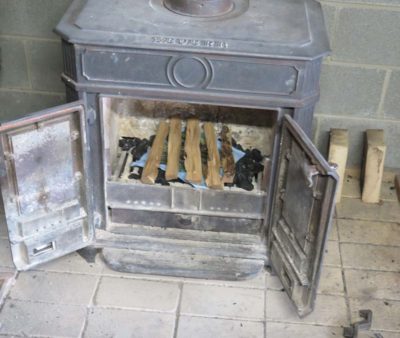Mastering the Cast Iron Stove
Now that the last bluster of winter is in the rearview mirror, it was a pleasingly and comparatively mild winter, and spring is in the headlights (we hope) it’s time to reflect on the utility of my cast iron bi-fuel stove for the barn. Finally, after three winters of trial-and-error I think I have it down to the point where it is the reliable workhorse heat source I had always hoped for.

To recap, the unit is a smallish British wood-and-coal stove probably of the 1970s vintage. Though smaller than the cast iron fireplace insert for the cabin, it is considerably heavier (the barn stove weighs in at about 525 pounds) due to the need for a firebox that can handle both wood and coal. I went on line to retrieve both the owner’s manual and to view youtube videos on the operations of such stoves. That was not the least bit helpful. In fact, I believe the owner’s manual was written by people who eventually became computer software instruction manual writers; neither had any usefulness for the end user, being written only by and for someone who already possessed full mastery of the “information” contained therein. Of course, it is possible that there is a contextual implication and perhaps those inculcated with the cultural norms of Britain are predisposed to operate such a device.
The stove is not located in the studio, it is in the basement directly underneath it. Thus it requires a long, steady heat in order to get the warmth up to my work space. Following the instructions on youtube served only to frustrate me, and I had to re-invent using this stove myself. Once that was done the use of this heater became a pleasure.

Here is the routine I have devised after scores of attempts, and is one I find to provide steady and constant warmth to my work space. A typical cycle for heating with the stove is 48 hours, by which I mean I can keep it running steadily but must clean out the ashes and clinkers every other morning. It usually requires 1-1/2 buckets’ worth of cleanout.

With the firebox emptied, the building of an effective heating fire can begin.

I begin this process by laying down about a roughly 2″ layer of nut coal as the bed for the fire and the foundation for the roaring heat to come.

On top of the bed of coal I place a single firestarter. If you are sharp-eyed with a good memory, you will recognize the firestarter as a piece of paper towel I used for the final filtering of our beeswax upstairs. I use one new filter for each platter of molten wax, so I’ve got a good (if not excess) inventory of this aid.

Next comes the whole reclusive woodsman skill set in constructing the kindling/firewood conflagration.

Each layer of fuel gets more massive.

Finally the firebox is completely full of dried maple, locust, and oak awaiting a flame.

Then, the flame.

Once the flame is going, I close the left door completely and close the right door to about 1″ opening to maximize the air flow.

10-15 minutes later I check back on the fire to make sure it is doing what I want it to be doing.

If going well, and a this point of my experience it always is, I place the iron fences at the front of the firebox to allow “banking” of the coal throughout the day.

Within a half hour the stove pipe is plenty hot, and upstairs it radiates heat into the shop.
From this point on I add fuel to the fire every hour or so until early afternoon. At the 1-hour point I add about three pieces of firewood along with three scoops of coal, at the 2-hour mark two pieces and four scoops, at 3 hours one piece and five or six scoops, and just after lunch another half dozen scoops of coal with no new firewood. I close the doors both firmly and make sure the flues are wide open (the gates are right behind the ceramic panels in the doors) and can usually hear whistling sound of the combustion air being drawn through.
As I wrap up the day at 6PM I pack the firebox as full as I can with coal, close the doors and tighten the latch, and close the gates halfway. Next morning when I arrive in the shop at about 8.30, the pace is still toasty warm and the fire is glowing red. I do a partial clean-out of the firebox by agitating the movable grates and emptying the ash drawer underneath, and spend the second day just shoveling in coal every few hours.
On even the coldest day of the winter — temps in the teens and nearly gale force winds — the workshop space was a cozy 64 degrees all day long (cozy because I am dressed for winter, after all). On such a day I will use 1-1/2 50-pound bags of nut coal, on a milder day 3/4-1 bag will suffice.
While I am not anxiously awaiting the next winter, I now know I can keep my own workspace cozy and amenable, and I still get to look out at the mountains any time I want.


Join the Conversation!